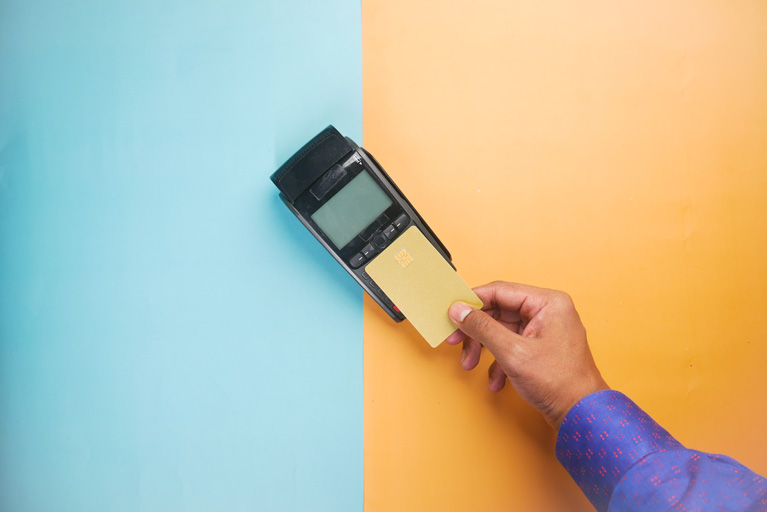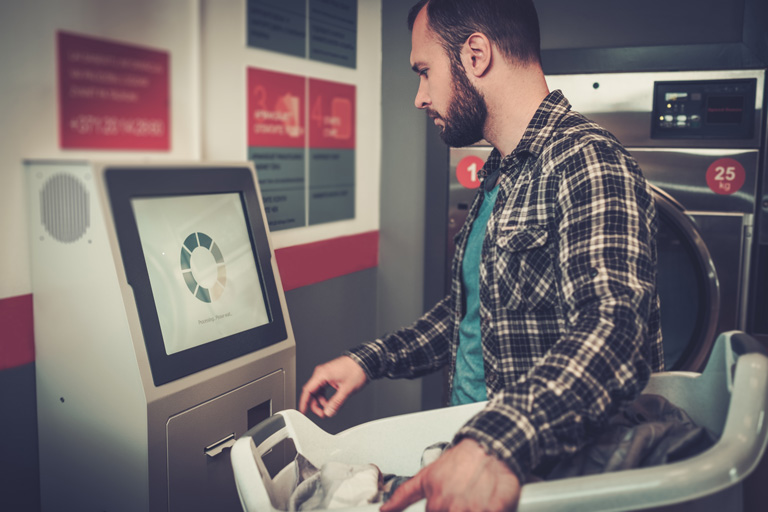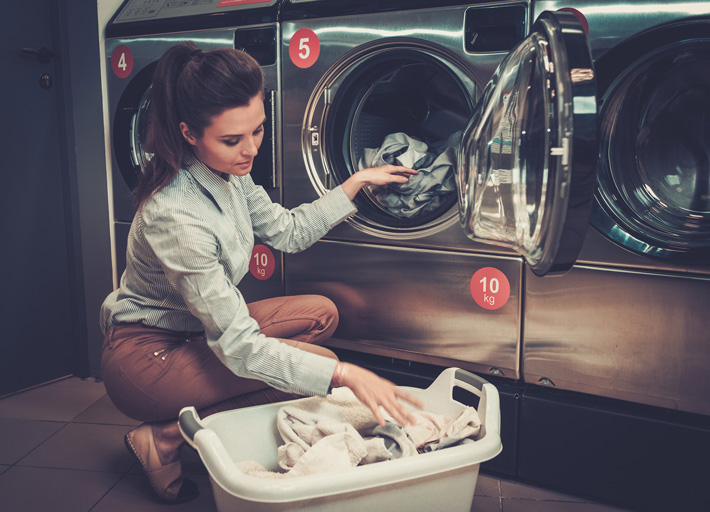Laundromats and communal laundry rooms—like those in an apartment or those in a college dorm—are venues where you should implement laundromat payment systems to accept credit and debit cards, in addition to other forms of mobile payment. A debit and credit card payment system attached to every washing machine may require some upgrading. But card readers for every laundry machine will have a great long-term ROI.
That’s because laundromat owners will find that a credit card laundromat (so to speak) is a much easier business to run than a cash-powered laundromat—for a number of reasons. Including safety, maintenance, payment security, and even customer experience.
Is the Laundromat Business a Boom or Bust?
Like anything else, there is a mixed assessment of the business of laundromats. One estimate from Grandview research suggests that the cash-powered laundromat business is booming. According to this particular market analysis report, coin-operated washers and dryers will be valued as a $30 billion business by 2027. This is a CAGR of more than 9% during the forecast period.
This study attributes the rise of cash-operated communal laundry facilities to a growing working-class population, particularly in urban areas. More explicitly because of a rising number of young female consumers with disposable income.
Yet other studies suggest that the laundromat is a dying breed. Another industry research from Ibis World suggests that business will decrease at an annualized rate of 1.3% over the next five years. Even with a slight increase of 1.9% in 2022, which resulted in a domestic industry value of $5.5 billion.
This study found that rising disposable income and falling unemployment will spur industry growth. But those factors may not be enough to keep the laundry business cycling. It may just be left out to dry for good. Of course, with an economy of renters fueled by a steady stream of college graduates, laundromats will still be a necessity.
A quick comparative analysis of these two reports may reveal the root cause of their disparity. The first report is talking about the global market. Which includes developing countries where until this point people have actually been laundering their clothes in natural sources of water. Something that most American consumers think is reserved for TV shows about the Oregon Trail or pioneering life.
The second study from Martin Ray Laundry Systems is focusing on the domestic market of different laundry businesses around the United States. Like anything else, business owners will find that macrocosmic reviews of an industry may not relate to their microcosmic market.

Laundromat Owners Are Taking New Approaches to the Business
An important factor in developing a laundromat business might be location, location, location…and alcohol? The laundromat has always been a social experience where diverse groups of people come together for clean clothing. Sometimes at odd hours of the night.
Some laundromat owners are embracing this idea and running with it, combining their laundromat with a restaurant or bar. If you’re going to spend 90 minutes washing and drying your clothes, why not enjoy a drink or two?
This strategy circumnavigates market concerns about consumers preferring in-unit appliances by tapping into their need for social interaction. And perhaps the fascinating form of entertainment that can only be found by watching clothes spin.
But even if you’re not turning your laundromat into a bespoke destination with open mic night or wood-fired pizza, there is still one new approach you should be taking if you haven’t already: laundromat payment systems.
Laundry Payment Systems Benefits
Laundromat payment systems have many benefits for merchants looking to keep their businesses running smoothly and customers happy. Let’s take a look at the top benefits that payment systems can provide for your laundromat business including:
- Increased safety
- Increased security
- Decreased maintenance
- Improved customer experience
Laundry Payment Systems Increase Safety
It’s no secret that cash-powered businesses attract crime. In the case of laundromats, this won’t be something white-collar like money laundering (pun intended) but a violent crime. The kind involving firearms, or the occasional machete (what else can you expect in the city that never sleeps). Bronx antics aside, violent criminals seeking cash may find a laundromat a profitable source of cash flow. And we’re not talking about the quarters.
While the cash in the machines is attractive, it also necessitates a visit to the nearest Coinstar machine. Or (even worse) putting coins in those little brown paper rolls, and taking them to the bank. Which is a real drag if you’re trying to live a fast life. It’s actually the customers entering the laundromat that are a more attractive source of quick and easy paper—the dollars they’ve brought to exchange for quarters, for instance, and all other monies in their wallets.
Laundromats that take credit cards and especially those that only take cards (or other digital payments) can eliminate this problem entirely or at least the cash crime problem. It will not eliminate crime entirely. Because smartphone theft, for example, occurs especially in urban areas like New York (you may be noticing a pattern here).
However, companies like Apple have proactively dealt with this problem by creating features and databases that make it harder for stolen phones to be reactivated for a new user. All of this bodes well for wash cycles powered by credit cards or digital wallet options like Apple Pay. Yes, laundromat apple pay is an option!
Laundry Payment Systems Increase Payment Security
A laundromat that accepts credit card and debit card payments is also arguably more secure. One concern with cash-operated businesses is counterfeiting. Which does a significant amount of damage to businesses—as much as $220 billion per year. Putting $70 to maybe even $200 million in fake money into circulation.
Counterfeiting money is usually reserved for big bills, but some people are just really desperate for clean clothes. Or they might be using $20, $10, and even $5 bills to score some quarters. Which they’ll then exchange somewhere else back into real currency.
Although we said earlier that laundromats don’t attract crimes like money laundering, this might be one instance where that can occur on a smaller scale—and it has been documented. If your laundromat is one without an attendant, the risk of counterfeit cash payments is heightened.
Some smelly criminals in desperate search of clean clothes will use a piece of metal called a slug to fool coin machines. The slug can be a metal washer, or it might be a form of foreign coinage that can fool cash-operated machines. Which is particularly beneficial if the exchange rate is substantial. Asking customers to use a credit card for the washing machine will significantly reduce cash-related fraud.
Laundry Payment Systems Decrease Maintenance
If your machines only take cash, you’re going to have to collect that cash at least once a week– possibly more often, depending on how busy you are. And if you don’t do the cash sweep, you’re going to have to pay an agency to do it for you.
A laundromat that takes debit cards and credit cards (along with other digital payments), by contrast, is going to involve a lot less maintenance. If customers break the coin operating component of the machine, you’re going to need to fix it yourself. Or hire someone who knows what they’re doing. Which might cost anywhere from $85 to $150 or more, depending on what the problem is.
By contrast, debit and credit payments create a seamless, nearly-maintenance-free experience for laundromat owners. You may consider still offering cash payments as an option. But if you really want to provide the convenience of cash for piggy bank customers, you might also consider one cash terminal that provides a laundromat debit card that can be reloaded. Sort of like a prepaid arcade card.
And come to think of it, pairing your laundromat with an arcade might not be a bad idea…one idea that’s also been explored by other laundromat owners. In any case, shifting more customer payments at the point of wash to the card over cash will help significantly reduce your time and money investment in active maintenance. Money card laundry reloads online could even be an option if you prefer not to have a cash machine.
Laundry Payment Systems Improve Customer Experience
It’s no secret that consumers prefer not using cash. In fact, according to CNBC, over the course of a week, 30% of American consumers don’t make a single purchase using cash. For some consumers, a cash-only laundromat is inconvenient. It necessitates the extra step of going to the ATM to get bills, then exchanging those bills for cash.
Consumers these days prefer to pay for things with credit and debit. And a significant number of them are preferring even more digital forms of payment without a magnetic strip or chip—things like Venmo or micropayment systems.
Integrating credit and debit processing into your business can also facilitate something like digital loyalty cards. Which certainly improves customer experience. If your laundromat is located in an area where you have to compete with laundromats, a loyalty program can keep the loads coming.
Only 55% of the homes in New York City have a washing machine, 65% in Los Angeles, and 69% in San Francisco. If you don’t want potential customers washing their clothes somewhere else, a loyalty program can improve your odds. And unless you’re going to pay an attendant to stand around 24/7 with a very uniquely shaped hole puncher, loyalty programs are best implemented as digital content via online payment platforms.

Types of Laundromat Payment Systems and Methods
Now that we know the benefits of offering card payment solutions in your laundromat, let’s take a look at how to actually implement it.
Card Readers
The most obvious form of collecting credit and debit payments is a laundromat credit card reader. These types of devices will be synched up with the washers and dryers so that customers cannot use them without payment.
A POS terminal in the form of a card swiper and/or chip reader can replace or supplement the traditional coin payment option. Contrary to what you might think, you do not have to purchase a commercial washer or dryer with a built-in card reader. You can add a card reader, replace card reading hardware, install a self-serve digital kiosk, and even swap out coin-operated machinery with a POS terminal.
QR Codes
Another method for collecting payments is to utilize QR codes. A QR code is an array of black and white squares that may or may not represent something recognizable. These codes can be posted on each machine or in one location for customers to scan with their smartphone cameras. They will then be directed to a payment gateway for your laundromat where they can make a micropayment (small transaction) for a wash and spin.
One downside to QR codes is that they will be lumped into card-not-present forms of payment. Which can result in higher interchange fees. Some types of QR codes also may require an active subscription, although others do not. One other disadvantage is that customers without a phone camera, or who are unfamiliar with the idea of QR codes, may have a limited ability to use them.
Contactless Payments
Contactless payments involve a customer tapping or hovering their card or mobile device over the payment terminal. Contactless payments are facilitated by NFC (near-field communication) technology. This technology allows customers to hold their phone near a POS terminal or card reader to complete the payment, without having to touch anything.
NFC payments soared during the recent pandemic, with a 30% increase in 2021 alone according to CNBC. Moreover, as many as half of polled consumers say they wouldn’t shop somewhere without contactless payments.
And unless the half that will is also the same half without washing machines, that means some potential customers won’t want to wash their clothes in your laundromat–unless you offer contactless payment options.
Digital Wallets
Digital wallets create a space to store credit card and debit card information on a smartphone. This technology can be paired with the aforementioned NFC to facilitate contactless payments without customers having to take out the plastic at all.
This can be especially convenient for customers who left their wallets behind. Which may actually occur more often in the setting of a laundromat. Consider, for instance, that a customer may have removed their wallet from their pants in order to plop them in dirty laundry…only to realize when they’re in front of the machine that they left their wallet at home. POS terminals with NFC technology can save them an aggravating trip home to get their billfold.
Micropayments
Another solution is to direct customers to a website where they can make micropayments using their preferred payment method. This could be a credit card, ACH from bank accounts, or a PayPal charge (to name a few options). A micropayments platform will allow users to make purchases that are less than they’d normally make on anything, without facing a surcharge or transaction fee.
For example, most consumers are not going to spend more than a few dollars on laundry at one time. An amount of money that many merchants would be reluctant to take a credit card for, because of the interchange fees.
A micropayments platform serviced by a boutique payment processor may be able to provide more nuanced tailoring in terms of a payment solution that won’t eat into your profits with fees. Although micropayments are most commonly used for digital goods (like renting a movie), given the cost of washing laundry and the fact that it’s not a tangible good, leveraging a micropayment platform might make sense.
Cash
There is something to be said for still accepting cash. If you are going to accept cash, you should still probably upgrade your devices and make sure they accept dollar bills. Because a coin shortage in recent years means that consumers are holding less change in their pockets than they used to.
Where all these coins went is a discussion beyond the scope of this article, but you may find some under your couch cushions. In any case, continuing to accept cash should be paired with a change machine on premises, under the watchful eye of a security camera to catch anyone potentially laundering $20 bills into coinage.

Prepaid Cards
Prepaid cards have their own expenses (namely, the plastic and the software to service them). But they may provide a beneficial method of collecting payment because they encourage customer loyalty.
As mentioned, the prepaid cards can be linked to a loyalty rewards or points program that keeps customers coming back. Rewards could include a free wash and dry every ten uses, for instance, or a gift card for every $50 or $100 spent at a neighboring business that would like to partner with your laundromat.
Another factor that prepaid cards offer is convenience, especially if the laundry card can be reloaded online. An even more digitized extension of the prepaid card option is to have your own app where customers can preload money and get rewarded for washing clothes.

Should Your Laundromat Have a Payment System?
Absolutely. While cash (particularly coins) has been the longstanding method of collecting payment for a laundromat, payment systems present several benefits including safety, security, maintenance, and customer experience.
There are a number of different ways a payment system can facilitate payments. From card readers to contactless NFC technology to QR codes to prepaid cards. There is no one size fits all approach in terms of hardware, software, and the costs to set it up.
Speaking to a payment processor about the nature of your laundromat—where it’s located, how many machines you have, and how much you’re charging—is an important first step towards making laundry payment systems part of the cycle.
To contact sales, click HERE. And to learn more about ECS Payment Processing visit Credit & Debit.
